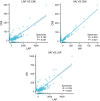Novel anthropometric indicators of visceral obesity predict the severity of hyperlipidemic acute pancreatitis
- PMID: 38654370
- PMCID: PMC11619407
- DOI: 10.1186/s12944-024-02112-1
Novel anthropometric indicators of visceral obesity predict the severity of hyperlipidemic acute pancreatitis
Abstract
Background: Obesity substantially contributes to the onset of acute pancreatitis (AP) and influences its progression to severe AP. Although body mass index (BMI) is a widely used anthropometric parameter, it fails to delineate the distribution pattern of adipose tissue. To circumvent this shortcoming, the predictive efficacies of novel anthropometric indicators of visceral obesity, such as lipid accumulation products (LAP), cardiometabolic index (CMI), body roundness index (BRI), visceral adiposity index (VAI), A Body Shape Index (ABSI), and Chinese visceral adiposity index (CVAI) were examined to assess the severity of AP.
Method: The body parameters and laboratory indices of 283 patients with hyperlipidemic acute pancreatitis (HLAP) were retrospectively analysed, and the six novel anthropometric indicators of visceral obesity were calculated. The severity of HLAP was determined using the revised Atlanta classification. The correlation between the six indicators and HLAP severity was evaluated, and the predictive efficacy of the indicators was assessed using area under the curve (AUC). The differences in diagnostic values of the six indicators were also compared using the DeLong test.
Results: Patients with moderate to severe AP had higher VAI, CMI, and LAP than patients with mild AP (all P < 0.001). The highest AUC in predicting HLAP severity was observed for VAI, with a value of 0.733 and 95% confidence interval of 0.678-0.784.
Conclusions: This study demonstrated significant correlations between HLAP severity and VAI, CMI, and LAP indicators. These indicators, particularly VAI, which displayed the highest predictive power, were instrumental in forecasting and evaluating the severity of HLAP.
© 2024. The Author(s).
Conflict of interest statement
The authors of this manuscript declare no relationships with any companies whose products or services may be related to the article’s subject matter.
Figures




Similar articles
-
The visceral adiposity index predicts the severity of hyperlipidaemic acute pancreatitis.Intern Emerg Med. 2022 Mar;17(2):417-422. doi: 10.1007/s11739-021-02819-4. Epub 2021 Aug 2. Intern Emerg Med. 2022. PMID: 34341894
-
Visceral obesity anthropometric indicators as predictors of acute pancreatitis severity.Front Med (Lausanne). 2025 Jul 11;12:1536090. doi: 10.3389/fmed.2025.1536090. eCollection 2025. Front Med (Lausanne). 2025. PMID: 40718412 Free PMC article.
-
Evaluation of the Severity of Hyperlipidemia Pancreatitis Using CT-measured Visceral Adipose Tissue.J Clin Gastroenterol. 2019 Aug;53(7):e276-e283. doi: 10.1097/MCG.0000000000001079. J Clin Gastroenterol. 2019. PMID: 29912754
-
Visceral adiposity and inflammatory bowel disease.Int J Colorectal Dis. 2021 Nov;36(11):2305-2319. doi: 10.1007/s00384-021-03968-w. Epub 2021 Jun 9. Int J Colorectal Dis. 2021. PMID: 34104989 Review.
-
Evolving perspectives on evaluating obesity: from traditional methods to cutting-edge techniques.Ann Med. 2025 Dec;57(1):2472856. doi: 10.1080/07853890.2025.2472856. Epub 2025 Mar 12. Ann Med. 2025. PMID: 40077889 Free PMC article. Review.
Cited by
-
Association between cardiac metabolic index and diabetic kidney disease: a cross-sectional study of NHANES 1999-2018.J Health Popul Nutr. 2025 Apr 3;44(1):105. doi: 10.1186/s41043-025-00826-1. J Health Popul Nutr. 2025. PMID: 40181374 Free PMC article.
-
Association of visceral obesity indicators with prostate cancer: a cross-sectional study from Xinjiang.Front Oncol. 2025 Jul 9;15:1614743. doi: 10.3389/fonc.2025.1614743. eCollection 2025. Front Oncol. 2025. PMID: 40703555 Free PMC article.
-
J-shaped relationship between Chinese visceral adiposity index and hyperuricemia: a cross-sectional study.Lipids Health Dis. 2024 Aug 24;23(1):267. doi: 10.1186/s12944-024-02247-1. Lipids Health Dis. 2024. PMID: 39182084 Free PMC article.
-
Reactive oxygen species and oxidative stress in acute pancreatitis: Pathogenesis and new therapeutic interventions.World J Gastroenterol. 2024 Dec 7;30(45):4771-4780. doi: 10.3748/wjg.v30.i45.4771. World J Gastroenterol. 2024. PMID: 39649547 Free PMC article.
-
CD36 Induces Inflammation by Promoting Ferroptosis in Pancreas, Epididymal Adipose Tissue, and Adipose Tissue Macrophages in Obesity-Related Severe Acute Pancreatitis.Int J Mol Sci. 2025 Apr 8;26(8):3482. doi: 10.3390/ijms26083482. Int J Mol Sci. 2025. PMID: 40331957 Free PMC article.
References
-
- Mederos MA, Reber HA, Girgis MD. Acute pancreatitis: a review. JAMA. 2021;325:382–90. - PubMed
-
- Gapp J, Hall AG, Walters RW, Jahann D, Kassim T, Reddymasu S. Trends and outcomes of hospitalizations related to acute pancreatitis: epidemiology from 2001 to 2014 in the United States. Pancreas. 2019;48:548–54. - PubMed
-
- Lankisch PG, Apte M, Banks PA. Acute pancreatitis. Lancet. 2015;386(9988):85–96. - PubMed
MeSH terms
LinkOut - more resources
Full Text Sources
Medical
Research Materials

